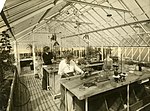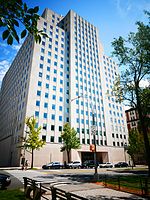Milbank, Brinckerhoff, and Fiske Halls

Milbank, Brinckerhoff, and Fiske Halls are historic buildings located on the campus of Barnard College in Morningside Heights, Manhattan, New York City. The three interconnected buildings are collectively known as Milbank Hall. They were designed by Charles A. Rich (1854–1943), built between 1897 and 1898, and contain classrooms, laboratories, administrative offices and dormitory. They are four stories on a raised basement built of dark red brick with white limestone and terra cotta details. They combine Italian Renaissance massing and detail with Colonial Revival inspired features. The roof of Milbank Hall houses the Arthur Ross Greenhouse.They were listed on the National Register of Historic Places in 2003.
Excerpt from the Wikipedia article Milbank, Brinckerhoff, and Fiske Halls (License: CC BY-SA 3.0, Authors, Images).Milbank, Brinckerhoff, and Fiske Halls
Claremont Avenue, New York Manhattan
Geographical coordinates (GPS) Address Nearby Places Show on map
Geographical coordinates (GPS)
| Latitude | Longitude |
|---|---|
| N 40.810555555556 ° | E -73.962777777778 ° |
Address
Barnard College
Claremont Avenue
10115 New York, Manhattan
New York, United States
Open on Google Maps






